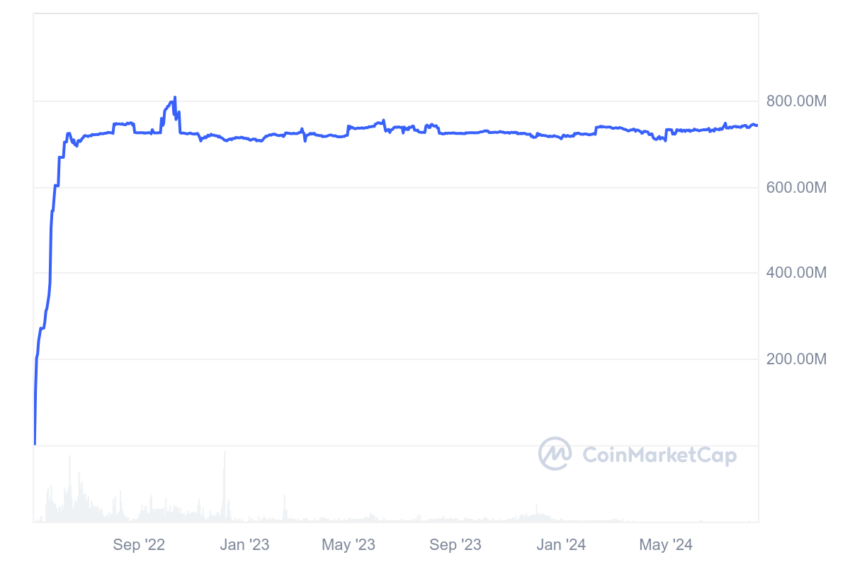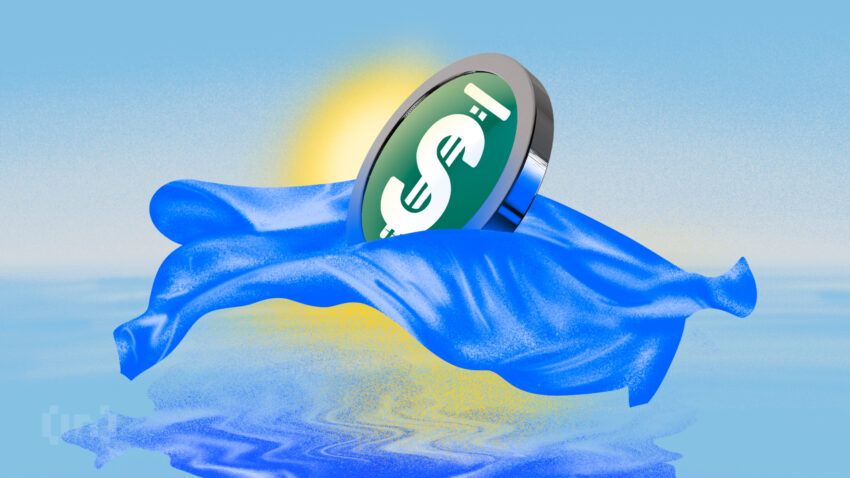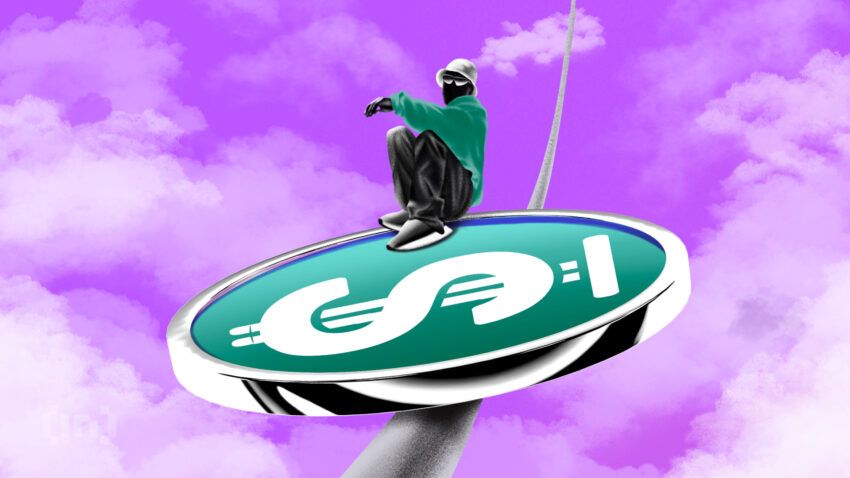USDD is a stablecoin pegged to the United States Dollar. It was launched on the Tron network, which is spearheaded by Justin Sun, a figure known for his bold marketing and high-profile crypto ventures. If you want to learn about the USDD stablecoin, this detailed guide covers everything you need to know in 2025.
KEY TAKEAWAYS
• USDD is an algorithmic stablecoin that is over-collateralized by TRX, BTC, and USDT.
• It is issued and maintained by the Tron DAO Reserve, a DAO for the Tron blockchain.
• USDD maintains its peg to USD by allowing redemptions of USDD with TRX and vice versa.
• It is issued natively on the Tron and Ethereum blockchains.
What is USDD stablecoin?
USD Digital (USDD) officially debuted on May 5, 2022, on the Tron, BNB Chain, and Ethereum blockchains. It is pegged to the U.S. dollar in a 1:1 ratio. This means that USDD maintains its value at a fixed exchange rate to the U.S. dollar, whereby 1 USDD is always supposed to be equivalent to $1.

As an algorithmic stablecoin, USDD shares many similarities with UST, the Terra stablecoin that used to rule the roost until its downfall. We’ll be delving into the details, including how USDD works and its underlying tokenomics, but first, let’s have a look at the team behind the token.
The team behind USDD

Tron, an EVM-compatible blockchain, launched the USDD stablecoin to replicate the success of Terra UST and LUNA, which at one point was the third-largest stablecoin by market cap (lagging only behind USDT and USDC).
Luna was one of the top cryptocurrencies with billions of dollars flowing into it, and all it took was one market downturn to turn this golden token into digital toilet paper…Not to mention UST, their stablecoin is still depegged.
Stephen Findeise (Coffeezilla), Crypto journalist
The Tron DAO Reserve is the current custodian of USDD. Tron was founded by Justin Sun in 2017. Justin Sun and Tronix (TRX), the native cryptocurrency of Tron, are already familiar names in the crypto market.
How does the Tron stablecoin work?
Without delving into the technical nitty-gritty, the USDD protocol allows traders to trade TRX for USDD to bring the price back into equilibrium with the dollar. Here is a more detailed explanation of how this process works.
When the price surges beyond the peg
Imagine a scenario when the demand for the Tron stablecoin is higher than the supply. The market dynamics will then cause the price to go above $1.
To bring the price back to $1, the USDD protocol temporarily allows users to swap $1 worth of TRX for 1 USDD. This swap burns $1 worth of TRX and mints 1 USDD. As more and more users execute these swaps, the resulting increase in USDD supply gradually stabilizes the price at $1 per token.
Note that there’s an incentive for users to participate in the process actively. That’s because these TRX to USDD swaps present an arbitrage opportunity for users that they can leverage to make profits.
For example, if the USDD price goes up to $1.10, then the new Tron stablecoin you have minted by swapping $1 worth of TRX will also be valued at $1.10 in a secondary market. You could then sell that USDD to make a net profit of $0.10 ($1.10 – $1.00 = $0.10). This may not seem like much, but the profits can add up to sizable numbers if done in large quantities.
When the price drops below the peg

Similarly, if the USDD price drops below $1 (say, to $0.90), you can buy 1 USDD for only $0.90 in a secondary market. You could then swap 1 USDD for $1 worth of TRX in the protocol. Each swap results in 1 USDD to burn in the system, which then gradually reduces its circulating supply.
The supply eventually drops, with more and more users swapping USDD for TRX. It then causes the price to come back to the target level (i.e., $1).
As for your incentives for participating in the process, you could now sell your $1 worth of TRX in an external market to make a profit of ($1- $0.9 =) $0.1 per swap.
The role of Tron Super Representatives
A stablecoin’s price dropping below the peg is a common occurrence. This is where the Tron Super Representatives have a big role to play. For those out of the loop, Super Representatives (SRs) are TRX holders who are responsible for producing blocks and packing transactions.
SRs are selected through a community vote where all TRX holders get a chance to cast their votes. The top 27 most-voted candidates are elected as SRs, and they play an important role by absorbing the volatility of the USDD price.
Each time the USDD stablecoin price drops below $1, the subsequent minting of TRX temporarily dilutes the minting power of the SRs. So, in a way, the SRs end up bearing the cost of USDD price volatility on behalf of the community.
The cost they incur is temporary, though. That’s because, in the medium to long run, the SRs are compensated with a portion of the token swap fee accumulated by the USDD protocol.
What are algorithmic stablecoins?
Algorithmic stablecoins are a type of cryptocurrency that maintains a stable value to another asset by automatically adjusting the supply in response to market demand. Some examples of algorithmic stablecoins are terraUSD (UST), frax (FRAX), neutrinoUSD (USDN), and magic internet money (MIM).
They’re called algorithmic because these assets use an algorithm to maintain their value when the price depegs. The idea here is to prevent depegging by regulating the supply-demand ratio.
In their purest form, these assets are uncollateralized, which is why they are also referred to as “uncollateralized stablecoins” sometimes. USDD, however, claims that it is over-collateralized.
You could argue that an algorithmic stablecoin is a true representation of decentralized assets because it doesn’t depend on any centralized entity to sustain itself. The algorithm itself takes care of all proceedings, including regulating the supply, demand, and target price.
USDD is over-collateralized
At launch, the Tron DAO Reserve promised to fully back USDD with a calibrated combination of stable and volatile assets. Justin Sun himself confirmed that USDD would be over-collateralized with a mix of high-quality, low-volatility assets. He further assured that that collateral would consist of the likes of BTC, USDT, and USDC.
Tron also promised a guaranteed minimum collateral ratio of 130% will be maintained at any given time. The collateralization ratio stands at just over 200%, with approximately $1.7 billion in reserves backing over 740 million USDD in circulation at a market cap of over $740 million, according to the Tron Dao Reserve website.
USDD vs. UST
| Feature | USDD | UST |
|---|---|---|
| Collateralization | Collateralized with TRX, BTC, USDT | Partially collateralized with BTC |
| Issuer | Tron DAO Reserve | Terraform Labs |
| Blockchain | Tron, BNB, and Ethereum | Terra |
| Collateralization | Currently operational | Collapsed in 2022 |
As algorithmic stablecoins, USDD and UST share many similarities. In fact, even the roadmaps of both tokens are nearly identical. However, Justin Sun insists that there are only so many similarities. He wrote in a blog post that Tron was taking every possible measure to make USDD immune from the vulnerabilities that led to the UST crash.
One of the main faults of the Luna-terraUSD ecosystem was that the vast majority of UST’s collateral consisted of LUNA. Bitcoin made only 15% of the collateral. Now, LUNA being a highly volatile asset, it was apparent that the very foundation of UST’s stability stood on shaky grounds.
In contrast, Tron has made it a point to collateralize USDD with multiple high-quality assets with comparatively low volatility.
How to buy the USDD stablecoin?
USDD can be bought or traded on several major centralized (CEX) and decentralized exchanges (DEX). Some of the most popular CEX for purchasing USDD are Kraken, Bybit, and MEXC.
On some of these exchanges, such as Poloniex, you can also buy USDD with fiat. The process is relatively simple for anyone who has used a crypto exchange before. In the case of Poloniex, just follow these steps (the process will be more or less similar in other exchanges)
- Navigate to your exchange wallet and choose “Buy with Fiat.”
- Choose EUR (or relevant currency) from the list of available fiats.
- Next, choose USDD and the amount that you want to buy.
- Click on proceed after reading the disclaimers. Note that you may have to show a valid ID to execute the order.
Is USDD a good investment choice?
Overall, it seems that Tron is indeed taking a slew of measures to ensure that USDD’s value remains intact even during adverse situations. The decision to collateralize the token with relatively more stable assets such as BTC and USDT (in addition to TRX) is a good step in that direction.
So, all things considered, USDD could be worth looking into. However, at the risk of stating the obvious, all crypto investments come with an element of risk, and USDD is no exception. Therefore, before investing, always make sure to do your own research and consult a financial expert.
Frequently asked questions
Is USDD a stablecoin?
Where can I buy USDD Tron?
What is the most stable stablecoin?
Is USDC safe?
Is it worth buying a stablecoin?
Is USDD safe?
Disclaimer
In line with the Trust Project guidelines, the educational content on this website is offered in good faith and for general information purposes only. BeInCrypto prioritizes providing high-quality information, taking the time to research and create informative content for readers. While partners may reward the company with commissions for placements in articles, these commissions do not influence the unbiased, honest, and helpful content creation process. Any action taken by the reader based on this information is strictly at their own risk. Please note that our Terms and Conditions, Privacy Policy, and Disclaimers have been updated.



